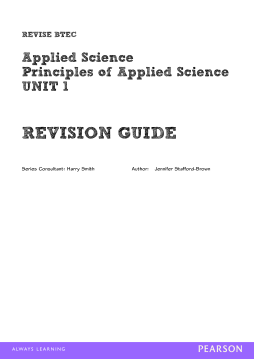
BOOK
BTEC First in Applied Science: Principles of Applied Science Unit 1 Revision Guide
(2017)
Additional Information
Book Details
Abstract
Resources designed to support learners of the new next generation BTEC First in Applied Science: Principles of Applied Science specification*.
This Revision Guide has been specifically written for externally assessed Unit 1: Principles of science in Award 1 of the Level 2 BTEC Firsts in Applied Science.
The guide is organised by the assessment structure of the qualification and gives students guidance on the external assessment.
- Key point summaries of what candidates should know are included to reinforce teaching.
- Information is presented in a straightforward, user-friendly way.
Worked examples, exam questions, revision practice questions and 'test yourself' diagnostic questions prepare students for the exams ahead. In addition, the Revision Guide provides students with all the answers to all the questions in the book.
* From 2012, Pearson’s BTEC First qualifications have been under re-development, so schools and colleges could be teaching the existing 2010 specification or the new next generation 2012-2013 specification. There are different Student Books to support each specification. If learners are unsure, they should check with their teacher or tutor.
Table of Contents
| Section Title | Page | Action | Price |
|---|---|---|---|
| Cover | Cover | ||
| Contents | ii | ||
| Learning aim A: Explore cells, organs and genes | 1 | ||
| 1: Cell structure and function 1 | 1 | ||
| 2: Cell structure and function 2 | 2 | ||
| 3: Plant cell organelles | 3 | ||
| 4: Animal cell organelles | 4 | ||
| 5: Cells, tissues and organs | 5 | ||
| 6: Function of plant organs | 6 | ||
| 7: DNA | 7 | ||
| 8: Chromosomes and genes | 8 | ||
| 9: Alleles, genotypes and phenotypes | 9 | ||
| 10: Punnett squares and pedigree diagrams | 10 | ||
| 11: Predicting genetic outcomes | 11 | ||
| 12: Genetic mutations | 12 | ||
| Learning aim B: Explore the roles of the nervous and endocrine systems in homeostasis and communication | 13 | ||
| 13: Homeostasis | 13 | ||
| 14: The nervous system | 14 | ||
| 15: Involuntary and voluntary responses | 15 | ||
| 16: Synapses | 16 | ||
| 17: Control of blood glucose | 17 | ||
| 18: Differences between the endocrine and nervous systems | 18 | ||
| 19: Thermoregulation | 19 | ||
| 20: Learning aim B: 6-mark questions | 20 | ||
| Learning aim C: Explore atomic structure and the periodic table | 22 | ||
| 22: The structure of an atom 1 | 22 | ||
| 23: The structure of an atom 2 | 23 | ||
| 24: Atomic number and mass number | 24 | ||
| 25: The periodic table 1 | 25 | ||
| 26: The periodic table 2 | 26 | ||
| 27: Isotopes and relative atomic mass | 27 | ||
| 28: Filling electron shells 1 | 28 | ||
| 29: Filling electron shells 2 | 29 | ||
| 30: Electron shells and groups | 30 | ||
| 31: Metals and non-metals | 31 | ||
| Learning aim D: Explore substances and chemical reactions | 32 | ||
| 32: Compounds and formulae | 32 | ||
| 33: Elements, compounds and mixtures | 33 | ||
| 34: Word equations | 34 | ||
| 35: Balanced chemical equations | 35 | ||
| 36: Acids, bases and alkalis | 36 | ||
| 37: Neutralisation reactions | 37 | ||
| 38: Equations for neutralisation reactions | 38 | ||
| 39: Reactions of acids with metals | 39 | ||
| 40: Reactions of acids with carbonates | 40 | ||
| 41: Tests for hydrogen and carbon dioxide | 41 | ||
| 42: Hazard symbols | 42 | ||
| 43: Applications of neutralisation reactions | 43 | ||
| 44: Learning aim D: 6-mark questions 1 | 44 | ||
| 45: Learning aim D: 6-mark questions 2 | 45 | ||
| 46: Balanced equations for reactions with acids | 46 | ||
| Learning aim E: Explore the importance of energy stores, energy transfers and energy transformations | 47 | ||
| 47: Forms of energy | 47 | ||
| 48: Uses of energy | 48 | ||
| 49: Energy stores | 49 | ||
| 50: Thermal energy transfers | 50 | ||
| 51: Measuring energy | 51 | ||
| 52: Power | 52 | ||
| 53: Paying for electricity | 53 | ||
| 54: Efficiency of energy transfers | 54 | ||
| 55: Renewable energy resources | 55 | ||
| 56: Non-renewable energy resources | 56 | ||
| 57: Using energy effectively | 57 | ||
| 58: Learning aim E: 6-mark questions 1 | 58 | ||
| 59: Learning aim E: 6-mark questions 2 | 59 | ||
| Learning aim F: Explore the properties and applications of waves in the electromagnetic spectrum | 60 | ||
| 60: Wave characteristics | 60 | ||
| 61: Wave calculations | 61 | ||
| 62: The electromagnetic spectrum | 62 | ||
| 63: Radio waves | 63 | ||
| 64: Microwaves | 64 | ||
| 65: Infrared radiation | 65 | ||
| 66: Visible light | 66 | ||
| 67: Ultraviolet light | 67 | ||
| 68: X-rays | 68 | ||
| 69: Gamma rays | 69 | ||
| 70: Answers | 70 | ||
| 75: Your own notes | 75 |
